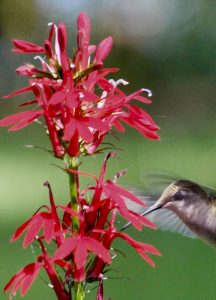Authored by: Carolyn Aita, Master Garden Volunteer Intern

Soon we will be celebrating Independence Day. The symbolic colors of our flag speak to our better angels: red for hardiness and valor, white for purity and innocence, blue for vigilance, perseverance, and justice. A patriotic plant trio, cardinal flower, American mountain mint, and great blue lobelia, has grown in North American moist meadows, along rivers, and at woodland edges for millennia. Before European settlement, native Americans used these plants for medicine and ceremony and for improving interpersonal relations, as love charms and elixirs to ward off divorce. This historically interesting and venerable trio works well as perennial landscape plants in moist spots in Wisconsin gardens today. When planted together, they make a living tapestry with the colors of our flag.
Cardinal flower, Lobelia cardinalis, also called Indian pink, brings red to our patriotic trio. This clump-forming perennial starts as a single basal rosette and achieves a height of four to five feet. It is a prolific seeder and it is common to see new rosettes grow from seed on open ground near the mother plant. Characteristic of plants in the Bellflower (Campanulaeceae) family, the cardinal flower bloom is a spike, or raceme, of fire engine red tubular flowers that open from the bottom of the raceme first. Hummingbirds love these blooms and cardinal flower is a cornerstone of any hummingbird garden. Luckily for us, the process of “blooming up the raceme” is a slow one and we can watch lovely hummingbird visitors enjoy nectar for many weeks during the summer.
American mountain mint, Pycanthemum virginianum, brings white to our patriotic trio. Small white flowers arranged in flattened clusters rise above the delicate narrow-leaved foliage on this one-to three-foot tall branching perennial. True to its name, mountain mint is in the Mint (Lamiaceae) family and has the characteristic square stem and minty scent shared with its culinary relatives. Mountain mint is a favorite of foraging pollinators including bumble bees and other native bees, honey bees, wasps, flies, and butterflies.
Great blue lobelia keeps its promise to bring blue to our patriotic trio. Its scientific name, Lobelia siphilitica, shows that it is a close relative of cardinal flower. But great blue lobelia is shorter, one to four feet tall, and has more frequently branched stems than its red cousin, giving it a softer, less “militaristic” appearance. This is a plant you want to cuddle, not salute. The flowers of great blue lobelia are on racemes, which like cardinal flower, bloom from the bottom of the raceme first. Bumble bees are the chief pollinators of its five-lipped tubular flowers, using the lower three lips as a landing pad. In contrast, the cardinal flower does not have this landing pad and is pollinated chiefly by hummingbirds, who carry pollen on their wings from flowers they have visited.
Each of these native plants will make a beautiful addition to your garden in its own right. But if a patriotic tapestry is the goal, overlapping bloom periods should be considered. In our climate we can expect all of these plants to reliably bloom from the end of July to beyond Labor Day, another uniquely American holiday.
Happy gardening,
Carolyn Aita
Master Garden Volunteer Intern




